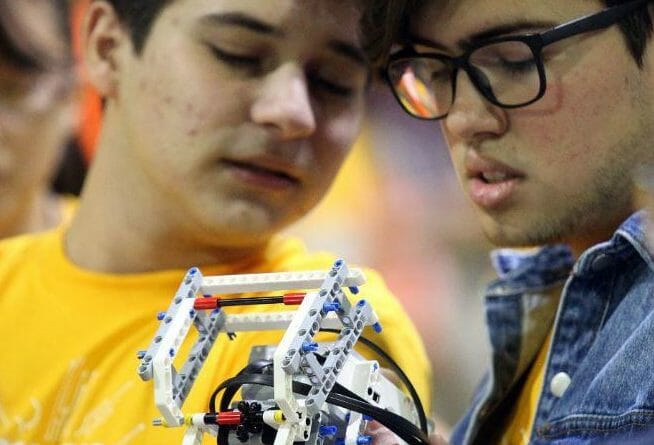Mind Over Machine: Valley Students Work Nuts and Bolts of HESTEC’s Robotics Day
Source: https://www.valleymorningstar.com
PHARR – IDEA North Mission students gathered around, frantically brainstorming what combination of commands to tap into their iPad. The group hustles together attempting to gauge the distance of a nearby incline their LEGO Mindstorms EV3 — an educational, programmable rolling robot — must scale, turn around and head back down.
As a team, they increased and decreased the path and range the bot traveled, sometimes veering off course.
Ashley Gangoo, 13, held the tablet controlling the bot. Her team blurted out guesses on how to prevent veering and increase distance. There was some debate about whether the cracks in the floor of the Pharr Events Center tripped the mounted color sensor, but like the other competitors troubleshooting their bot during Monday’s Robotics Day, they could only bet their hypotheses would pay off.
Robotics Day was part of the first-day festivities kicking off the University of Texas Rio Grande Valley’s Hispanic Engineering, Science and Technology, or HESTEC Week. This is the 17th annual celebration of STEM — science, technology, engineering and mathematics — for thousands of students, educators and community members.
Donna High School engineering teacher Julian Navarro called the preparation and contest a “real world simulation of what it is to be an engineer or to work on robots.”
“ Engineers do not work by themselves,” he said, “(and)…you don’t always get to work with your best buddy.”
Navarro said the time crunch of adjusting between rounds tested teams, and was good experience simulating an engineering team. More than 40 middle and high school teams from as far as Laredo had weeks to build their bot from Lego Mindstorms EV3s kits.
Programming robots is a fun, approachable way to hands-on STEM education, Navarro said. Educators could teach the same concepts repeatedly, but providing an immersive experience and competing against other students gives them a taste of the competitive field.
“ That’s the same as the real world as when a company competes with another company,” he said. “Now the stakes are so high here, it’s just for a trophy. But in the real world, the stakes are much higher.”
A push to learn
Norma Jean De Leon, academic content coach with UTRGV GEAR UP, said federal funding allowed 13 teams of Brownsville, Edinburg and La Joya middle schoolers to compete.
“ These teams wouldn’t have the chance otherwise,” said the former middle-school robotics sponsor. “I was here as a teacher with a group of kids, but now I get to bring all these kids.”
She said her hope was that the experience would spark an interest in engineering and STEM for local boys and girls. The event used to be larger, but she doesn’t think it’s because of a lack of STEM-focused activities.
While some potential teams don’t have the funding, other schools already compete in other kinds of robotics contests, like FIRST Robotics Competition.
It’s growing,” De Leon said, “and a lot of people are bringing these kinds of opportunities in the Valley. Other organizations are coming down, so that’s great.”
Milton Hernandez, program coordinator with UTRGV’s Division of Governmental and Community Relations, said teachers inquire about how organizers will make the contests more challenging every year.
“This pushes them more to learn,” Hernandez said.
Each round required modifications to their robots to complete four specific tasks — navigating a maze, scaling and descending an incline, tracing a line and a search and rescue. Teams could change tires, weight or other attributes depending on the obstacle.
“In reality, you’re building four different robots,” Hernandez said. “You’re just building them at different times. That’s what challenges them. They know what they’re coming into, but they don’t know if what they’re doing is going to work correctly at our event.”
Donna High School student Marcus Ysaguirre, 16, said the process was a lot of trial and error.
In the beginning, there “were disagreements, but we came together and really thought what would be the best concept for our robot,” he said.
When asked how they did this year, the team’s sentiment was simple: better than last year.
They’re able to learn from their mistakes and they’re able to correct it right after,” Hernandez said. “The reason we did this was to challenge them when they’re sitting down — when they’re not really competing.
“They’re thinking, ‘What do we need to do to build it better for the next one?’”
Climbing the ramp didn’t work out for Gangoo and her IDEA North Mission teammates.
“We pressed the wrong button, so it did the wrong program,” she said, but she was upbeat. “It was really fun and it made me think about engineering more.”
She confessed she didn’t initially think they’d successfully build a bot.
“We knew we only had a week. We didn’t think we were going to make it … (but) as we started to put things together, you can see how much easier it is when we work together,” Gangoo said. “As we worked together, we gained more confidence.”
And like her doubt about the team being proven wrong, so was her idea that she could never be an engineer, she said.
“I thought it would be too hard or impossible, but now I think maybe it’s a possible future career,” Gangoo said.

